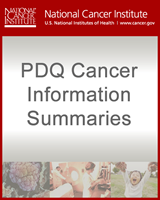|
Pediatric-type diffuse high-grade gliomas
| Diffuse pediatric-type high-grade glioma, H3-wild type and IDH-wild type | Childhood Astrocytomas, Other Gliomas, and Glioneuronal/Neuronal Tumors Treatment
|
| Diffuse midline glioma, H3 K27-altered |
| Diffuse hemispheric glioma, H3 G34-mutant |
| Infant-type hemispheric glioma |
|
Circumscribed astrocytic gliomas
| Pilocytic astrocytoma |
Childhood Astrocytomas, Other Gliomas, and Glioneuronal/Neuronal Tumors Treatment
|
| High-grade astrocytoma with piloid features |
| Subependymal giant cell astrocytoma |
| Pleomorphic xanthoastrocytoma |
| Choroid glioma |
| Astroblastoma, MN1-altered |
|
Ependymal tumors
| Subependymoma |
Childhood Ependymoma Treatment
|
| Myxopapillary ependymoma |
| Supratentorial ependymoma, NOS |
| Supratentorial ependymoma, ZFTA fusion–positive |
| Supratentorial ependymoma, YAP1 fusion–positive |
| Posterior fossa ependymoma, NOS |
| Posterior fossa group A (PFA) ependymoma |
| Posterior fossa group B (PFB) ependymoma |
| Spinal ependymoma, NOS |
| Spinal ependymoma, MYCN-amplified |
|
Pediatric-type diffuse low-grade glioma
| Diffuse astrocytoma, MYB- or MYBL1-altered |
Childhood Astrocytomas, Other Gliomas, and Glioneuronal/Neuronal Tumors Treatment
|
| Angiocentric glioma |
| Polymorphous low-grade neuroepithelial tumor of the young |
| Diffuse low-grade glioma, MAPK pathway-altered |
|
Glioneuronal and neuronal tumors
| Dysembryoplastic neuroepithelial tumor |
Childhood Astrocytomas, Other Gliomas, and Glioneuronal/Neuronal Tumors Treatment
|
| Ganglioglioma |
| Gangliocytoma |
| Desmoplastic infantile ganglioglioma |
| Desmoplastic infantile astrocytoma |
| Diffuse glioneuronal tumor with oligodendroglioma-like features and nuclear clusters (provisional entity) |
| Papillary glioneuronal tumor |
| Rosette-forming glioneuronal tumor |
| Myxoid glioneuronal tumor |
| Diffuse leptomeningeal glioneuronal tumor |
| Multinodular and vacuolating neuronal tumor |
| Dysplastic cerebellar gangliocytoma (Lhermitte-Duclos disease) |
| Extraventricular neurocytoma |
| Cerebellar liponeurocytoma |
| Central neurocytoma |
|
Tumors of the pineal region
| Pineoblastoma |
Childhood Medulloblastoma and Other Central Nervous System Embryonal Tumors Treatment
|
|
Embryonal tumors
| Medulloblastoma, WNT-activated |
Childhood Medulloblastoma and Other Central Nervous System Embryonal Tumors Treatment
|
| Medulloblastoma, SHH-activated and TP53-mutant; Medulloblastoma, SHH-activated and TP53-wildtype |
| Medulloblastoma, non-WNT/non-SHH |
| Medulloblastoma, histologically defined |
| Desmoplastic nodular medulloblastoma |
| Medulloblastoma with extensive nodularity |
| Large cell medulloblastoma |
| Anaplastic medulloblastoma |
| Embryonal tumor with multilayered rosettes, C19MC-altered |
| CNS tumor with BCOR internal tandem duplication |
| CNS neuroblastoma, FOXR2-activated |
| CNS embryonal tumor, NEC/NOS |
| Atypical teratoid/rhabdoid tumor |
Childhood Central Nervous System Atypical Teratoid/Rhabdoid Tumor Treatment
|
|
Germ cell tumors
| Germinoma |
Childhood Central Nervous System Germ Cell Tumors Treatment
|
| Embryonal carcinoma |
| Yolk sac tumor |
| Choriocarcinoma |
| Mature teratoma |
| Immature teratoma |
| Teratoma with somatic-type malignancy |
| Mixed germ cell tumor |
|
Tumors of the sellar region
| Adamantinomatous craniopharyngioma |
Childhood Craniopharyngioma Treatment
|
| Papillary craniopharyngioma |
